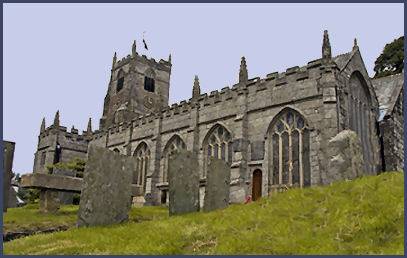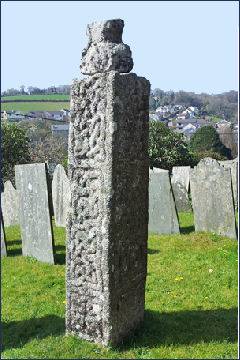St. Neot
OS Grid ref:- SX 1867
 The village of St. Neot is situated in a wooded valley on the southern edge of Bodmin Moor, lying near to Colliford Lake and the enigmatic Dozmary Pool.
The village of St. Neot is situated in a wooded valley on the southern edge of Bodmin Moor, lying near to Colliford Lake and the enigmatic Dozmary Pool.
The town is named in honour of Saint Neot, a Cornish monk, who was befriended by King Alfred the Great. By the time of the Domesday Survey in 1086 St. Neot was held by Odo, a sub-tenant of Robert, Court of Mortain, half brother of King William the Conqueror.
The imposing granite Village Church of St. Anietus (pictured lleft) boasts a series of seventeen superb stained glass windows which date back to the fifteenth and sixteenth centuries and are incredibly well-preserved with over half of the original glass. The glass depicts saints and angels and biblical stories. One of the windows depicts St Neot himself, who is said to have stood only four feet high, in a series of varying scenes. The building itself is built in the perpendicular style and dates from the fifteenth century.
The village was stauncly royalist during the Civil War, by tradition, an oak branch is hung from the top of the church tower each Oak Apple Day (May 29th). To commemorate the escape of Charles II, who in 1660, suceeded in hiding in the branches of an oak tree from Cromwell's Roundheads after his defeat at the battle of Worcester.
 A Holy Well, an ancient site of much historical interest, lies a short walk from the churchyard by the River Loveny (OS grid reference SX183681). It stands at the foot of a rocky outcrop covered in trees . St Neot is reported to have stood daily at the well reciting the Psalter and the well was once said to be the home of two holy fishes. Many incredulous tales exist of St. Neot's miraculous performances at this holy well, which an angel is said to have stocked with fish as food for the saint.
A Holy Well, an ancient site of much historical interest, lies a short walk from the churchyard by the River Loveny (OS grid reference SX183681). It stands at the foot of a rocky outcrop covered in trees . St Neot is reported to have stood daily at the well reciting the Psalter and the well was once said to be the home of two holy fishes. Many incredulous tales exist of St. Neot's miraculous performances at this holy well, which an angel is said to have stocked with fish as food for the saint.
The well was heavily restored in the nineteenth century, which is recorded above it, beneath the lettering is a wonderful time aged oak door with a lovely old catch which leads to three steps leading down to the water. The waters of this well are said to cure sick children, particularly in May around the time of Beltane. There is a colourful commemorative mosaic of the saint in the Market Square in St Neot (pictured right). The mosaic is based on a famous Saxon ornament, the Alfred Jewel.
The village pub, the London Inn, situated next to the church offers good food and accommodation. The name suggests it was a stopping place for travellers on route to London.
The nearby Carnglaze Slate Caverns, a former slate quarry, have been worked since ancient times and are well worth a visit. Guided tours of the caverns are available. Attractive Cardinham Woods are situated nearby and are perfect for woodland walks or cycle rides. The village of Cardinham has more examples of carved granite crosses in its churchyard.
The St. Neot Crosses
 The churchyard St. Anietus at St. Neot's contains no less than five ancient crosses, the most elaborate of which is sited just outside the church door and is known as the Trewarne Cross.
The churchyard St. Anietus at St. Neot's contains no less than five ancient crosses, the most elaborate of which is sited just outside the church door and is known as the Trewarne Cross.
The Trewarne Cross is a fine example of a granite Celtic cross which dates from the ninth century. Although it now has part of its top missing and is much worn, it is said to be one of the finest in Cornwall. The cross is richly engraved with interlacing Celtic patterns.
The cross is reputed to be the one which the renowned Anglo- Saxon king, Alfred the Great, gave to the Cornish saint Neot in the last half of the eighth century. Bishop Asser recorded that King Alfred visited St Neot to seek his counsel, while hunting near the village.
Neot, who is said to have been four feet in height, began his adult life as a soldier, but later renounced his martial lifestyle for a religious life. He served as sacristan at Glastonbury Abbey in Somerset, but later lived in Cornwall, at first alone, then with a growing group of other monks near Bodmin Moor. He was remembered because of his good work in caring for the poor. His bones were preserved as a holy relic in the village.
There are also four Latin style crosses in the churchyard, all were found as wayside crosses in the area and brought to the churchyard over the past 200 years.
Three probably date from the fifteenth century, one of the crosses is a lantern style cross. One of the these was brought here from the earthwork known as "Crowpound", on the summit of Goonzion Down, overlooking St. Neot's village.